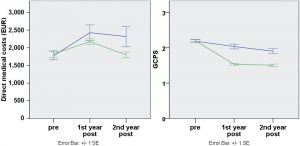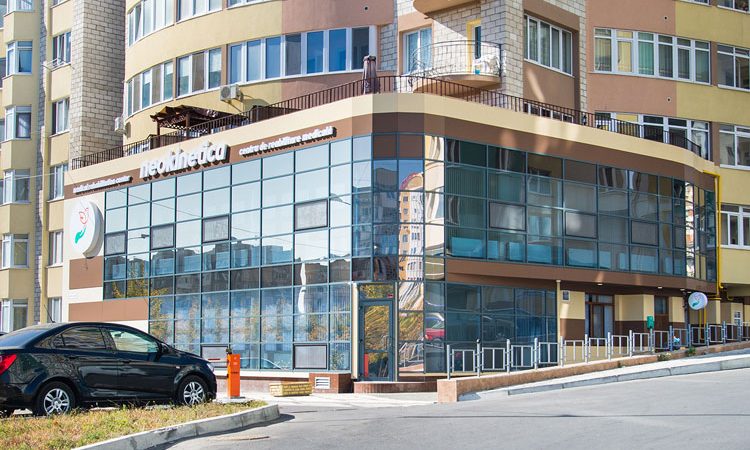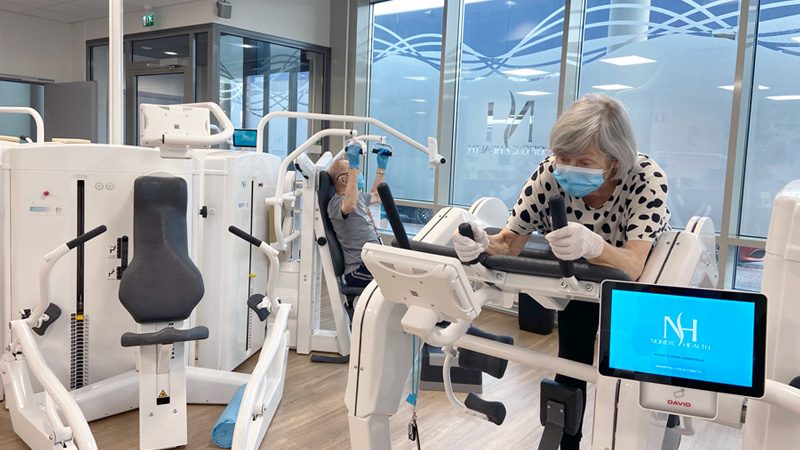Back pain is a massive problem worldwide
Back pain is the biggest cause of years lived with disability (YLDs) compared to any other disorder. Every fifth person worldwide suffers back pain monthly. In Western industrial nations over 70% of people will suffer back pain at some point of their lives. Luckily, most of the patients will get better in a month or two but 8-10% of the patients will develop chronic back pain. This is the group of patients that will incur the highest direct and direct costs.
Considering the high socioeconomic impact of back pain, it is a little wonder we know so little about the cost-effectiveness of various interventions. It is commonly accepted that exercise is an effective intervention for chronic back pain. However, despite years of research, it has remained unclear what type of exercise should be favored. With what intensity and how many sessions? Also, is there a variability in the clinical and economical outcomes depending on the severity of the back problems?
Background for the study
Since 2005 AOK, a major German statutory health insurer, has provided its clients suffering from back pain a multimodal back exercise program. It consists of strength, mobility and ergonomic exercises and is principally based on the David Spine Solution. Approximately 30,000 patients go through this program annually. Just published study by Gerhard Müller et al. compared the benefit of this program with standard care. In addition, the effect of the program on direct and indirect medical costs were investigated. Researchers also wanted to find out how the health and economic effects correlate with back pain severity.

What was done?
The research was a controlled multicenter study and the data was gathered in 39 locations equipped with the David Spine Solution in the German state of Baden-Wuerttemberg. The study included in total 1,829 individuals in an intervention group and 495 individuals in a control group. The Graded Chronic Pain Status (from 0 to 4) of all participants was at least grade 1 (low pain intensity). The intervention group went through a 6 month multimodal back exercise program in addition to the mandated health insurance services. The control group underwent only the mandated health insurance services which collectively make up the standard treatment program. Follow-ups where at 6, 12, 18 and 24 months.
The multimodal back exercise program consisted of dynamic strength training of the trunk stabilizers and neck muscles, functional gymnastics exercises, stretching and exercises in everyday motor activity. Exercises were conducted under supervision in groups of five. The program consisted of 36 one hour training sessions during 24 weeks. During the first 12 weeks 2 sessions per week and following 12 weeks 1 session per week. The main component of the exercise program was device-based strength and mobility training on five David Spine Solution devices (F110, F120, F130, F140 and F150). The intensity of training was increased progressively starting from under 30% of MVC (maximum voluntary contraction) with 35 repetitions ending up to 80-90% of MVC with 12 repetitions. During basic training phase (weeks 1-12) only one set on each device and in the maintenance training phase (weeks 13-24) two sets per device were performed.
Mobility and maximal isometric strength tests were conducted on the devices before, in the middle and in the end of the 6 months program. The possible weaknesses found in strength and mobility were considered in the program design. The weakest muscle group was trained first and in case of clear muscular imbalance the weaker side was trained first.
Every session included also ergonomic exercises, proper spinal seating posture and spine-friendly working and lifting techniques approximately 5 minutes per session. From 13th session onwards, home exercises for daily use were included.
The costs for the back exercise treatment were significantly lower, as much as 763 euros per patient, than for the standard treatment.
What was found?
Researchers found that back exercise program significantly reduced the most severe back pain and the mean level of back pain. It also reduced impairment of daily work and the number of days with pain (Figure 4.). There was a significant 0,4 reduction in the mean GCPS value compared to the standard treatment.
The direct medical costs between the groups didn’t differ much during the intervention period. However, during the second post-intervention year and for the entire intervention period, the costs for the back exercise treatment were significantly lower, as much as 763 euros per patient, than for the standard treatment.
 Figure 1. Economic impacts (direct medical costs per insured in EUR/year) on the left and therapeutic effects (Graded Chronic Pain Status scale) on the right. Green line represents back exercise treatment and blue line traditional treatment. (G. Müller et al., 2018)
Figure 1. Economic impacts (direct medical costs per insured in EUR/year) on the left and therapeutic effects (Graded Chronic Pain Status scale) on the right. Green line represents back exercise treatment and blue line traditional treatment. (G. Müller et al., 2018)
The therapeutic and economic effects of the program increased with severity of back pain.
What did authors conclude?
The authors note that the most important finding of this study was that the higher the back pain level (GCPS) is before the intervention, the more apparent the therapeutic effect is. According to the data, also the economic impact becomes more obvious the more difficult the experienced back pain before the intervention is. In other words, the therapeutic and economic effects of the program increased with severity of back pain (Figure 2).
 Figure 2. Economic impacts (direct medical costs per insured in EUR/year) on the left and therapeutic effects (Graded Chronic Pain Status scale) on the right for patients with GCPS pain level 4 (high disability – severely limiting). Green line represents back exercise treatment and blue line traditional treatment. (G. Müller et al., 2018).
Figure 2. Economic impacts (direct medical costs per insured in EUR/year) on the left and therapeutic effects (Graded Chronic Pain Status scale) on the right for patients with GCPS pain level 4 (high disability – severely limiting). Green line represents back exercise treatment and blue line traditional treatment. (G. Müller et al., 2018).
This is the first study that investigates both therapeutic and economic effects of a device-based rehabilitation program for patients suffering from chronic back pain. The significant benefits both economically and therapeutically speak for themselves.
The significant benefits both economically and therapeutically speak for themselves.
From the technological point of view, it’s quite interesting that the exercise program in this study utilized the previous generation David Spine Solution devices. Even though the devices are biomechanically superb, they are not equipped with the intelligent EVE technology.
Data from our client’s clinic in the USA shows a clear improvement in pain reduction results just by implementing EVE technology in the devices. The average VAS pain level decreased 18% in 24 sessions with EVE (n=261) compared to non-EVE group (n=454). Thus, It would be fascinating to see how much the therapeutic and economic effectiveness of the back exercise program would increase when utilizing our latest technology with all the sophistication of the EVE system. We know that the quality of the training and the motivation of the patients increase significantly when adding a real-time biofeedback system to a rehabilitation device. Only then the dosage of an exercise can be prescribed accurately – like a medicine should be prescribed.
Müller G, Pfinder M, Clement M, Kaiserauer A, Deis G, Waber T, Rieger S, Schwarz D, Heinzel-Gutenbrunner M, Straif M, Bös K, Kohlmann T. Therapeutic and economic effects of multimodal back exercise: A controlled multicentre study. J Rehabil Med. 2018 Nov 8. doi: 10.2340/16501977-2497.
The original publication can be found here: https://www.ncbi.nlm.nih.gov/pubmed/30406268
 English
English 
























